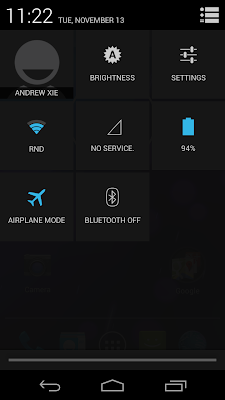Google Earth 3D
Thursday, November 29, 2012
Week 11 Dimension/ Depth/ Space/ Scale
Thursday, November 15, 2012
Week 10 Blog Tone and Color
For this week I chose Google's Android 4.2 operating system that was recently brought to market.
Keyboard |
| Quick Settings |
Tone is used very strongly in this operating system, primarily to create a certain style or "feel" that speaks to how advanced it is, as well as unifying different screens. The primary tones are strongly differentiated, with bright cyan, deep blacks and grey tones in between. A strong range of tone presented creates a vivid image.
How TONE is interacting-
Tone most importantly interacts with color, by combining the two, a uniform and flowing style is created. Also, by combining dark tones in the background next to light tones of color for text and icons, this allows for good legibility.
How COLOR is operating-
The colors chosen have meaning and reason, beginning with the continuation of cyan, as blue invokes a feeling of calmness. Also important is the exceptions to the cyan, black, white and grey color scheme in the desk clock screens. The red in this case is symbolic of the function, for example making the alarm text red, or very "alarming" itself.
How COLOR is interacting-
Color interacts strongly with saturation, in that the few bright colors against the mostly black or grey background are highly saturated, making them easier to read and stand out more. This also creates a crisp and vivid imagery throughout.
How TONE is interacting-
Tone most importantly interacts with color, by combining the two, a uniform and flowing style is created. Also, by combining dark tones in the background next to light tones of color for text and icons, this allows for good legibility.
How COLOR is operating-
The colors chosen have meaning and reason, beginning with the continuation of cyan, as blue invokes a feeling of calmness. Also important is the exceptions to the cyan, black, white and grey color scheme in the desk clock screens. The red in this case is symbolic of the function, for example making the alarm text red, or very "alarming" itself.
How COLOR is interacting-
Color interacts strongly with saturation, in that the few bright colors against the mostly black or grey background are highly saturated, making them easier to read and stand out more. This also creates a crisp and vivid imagery throughout.
Thursday, November 8, 2012
Week 10 Blog- Basic Elements in Automotive Design
- Mazda Kazamai Concept - Movement
The concept Kazamai, or dance, gives the appearance of motion even standing still. This is expressed in the curved lines on the doors, the grille, and even the shape and proportion, which use visual trickery to make the appear as if it is tensed up, and ready to pounce. By using organic shapes on an inorganic surface, the designers gave the appearance of movement and life.
The new Fiat 500 uses shape to create a vintage look on a modern vehicle. By using certain cues, such as the round headlights, the appearance is related to the original, even though the two are decades apart, vastly different in size, and on unrelated platforms. Circles are also used in the wheel arches, mimicking the original model, and in the shape of the car, as well as details.
The Hyundai Veloster uses line in many interesting ways. The character line along the side of the car gives definition, as well as visually shortens and lengthens the car, utilizing visual trickery to make the car better proportioned than it's front wheel drive economy car platform would allow. Another interesting use of line is in the front fascia, with a hard line dividing the grill, and again on the leading edges of the wheel arches, giving a more aggressive look, and suggesting air inlets for the brakes. As well as many details involving line, the overall effect is a car much more aggressive looking than it's actual underpinnings.
Thursday, November 1, 2012
Week 8- Visual Thinking Research
For this week's assignment, my friend and I both solved puzzles simultaneously. This is the results; her pen was purple, mine green.
Both of us took about 20 turns to complete the puzzle. The lowest possible was 14. Interestingly enough, both of us started from the outside, and took roughly the same path. The correct pattern begun on the inside and worked it's way out."The Cat"
This was an example of pattern recognition. On both this puzzle and the previous one, my friend and I both worked our way from top to bottom, and, on this puzzle, left to right, just like reading language. She got he correct number, 20, but I missed the overall eyes. Both of us used a method to check off the ones we had completed. This also was an example of grouping.
Subscribe to:
Comments (Atom)



